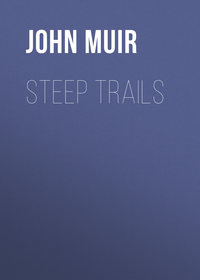 полная версия
полная версияThe Mountains of California
NUT PINE (Pinus monophylla)
The Nut Pine covers or rather dots the eastern flank of the Sierra, to which it is mostly restricted, in grayish, bush-like patches, from the margin of the sage-plains to an elevation of from 7000 to 8000 feet.
A more contentedly fruitful and unaspiring conifer could not be conceived. All the species we have been sketching make departures more or less distant from the typical spire form, but none goes so far as this. Without any apparent exigency of climate or soil, it remains near the ground, throwing out crooked, divergent branches like an orchard apple-tree, and seldom pushes a single shoot higher than fifteen or twenty feet above the ground.
The average thickness of the trunk is, perhaps, about ten or twelve inches. The leaves are mostly undivided, like round awls, instead of being separated, like those of other pines, into twos and threes and fives. The cones are green while growing, and are usually found over all the tree, forming quite a marked feature as seen against the bluish-gray foliage. They are quite small, only about two inches in length, and give no promise of edible nuts; but when we come to open them, we find that about half the entire bulk of the cone is made up of sweet, nutritious seeds, the kernels of which are nearly as large as those of hazel-nuts.
This is undoubtedly the most important food-tree on the Sierra, and furnishes the Mono, Carson, and Walker River Indians with more and better nuts than all the other species taken together. It is the Indians' own tree, and many a white man have they killed for cutting it down.
In its development Nature seems to have aimed at the formation of as great a fruit-bearing surface as possible. Being so low and accessible, the cones are readily beaten off with poles, and the nuts procured by roasting them until the scales open. In bountiful seasons a single Indian will gather thirty or forty bushels of them—a fine squirrelish employment.
Of all the conifers along the eastern base of the Sierra, and on all the many mountain groups and short ranges of the Great Basin, this foodful little pine is the commonest tree, and the most important. Nearly every mountain is planted with it to a height of from 8000 to 9000 feet above the sea. Some are covered from base to summit by this one species, with only a sparse growth of juniper on the lower slopes to break the continuity of its curious woods, which, though dark-looking at a distance, are almost shadeless, and have none of the damp, leafy glens and hollows so characteristic of other pine woods. Tens of thousands of acres occur in continuous belts. Indeed, viewed comprehensively the entire Basin seems to be pretty evenly divided into level plains dotted with sage-bushes and mountain-chains covered with Nut Pines. No slope is too rough, none too dry, for these bountiful orchards of the red man.
The value of this species to Nevada is not easily overestimated. It furnishes charcoal and timber for the mines, and, with the juniper, supplies the ranches with fuel and rough fencing. In fruitful seasons the nut crop is perhaps greater than the California wheat crop, which exerts so much influence throughout the food markets of the world. When, the crop is ripe, the Indians make ready the long beating-poles; bags, baskets, mats, and sacks are collected; the women out at service among the settlers, washing or drudging, assemble at the family huts; the men leave their ranch work; old and young, all are mounted on ponies and start in great glee to the nut-lands, forming curiously picturesque cavalcades; flaming scarfs and calico skirts stream loosely over the knotty ponies, two squaws usually astride of each, with baby midgets bandaged in baskets slung on their backs or balanced on the saddle-bow; while nut-baskets and water-jars project from each side, and the long beating-poles make angles in every direction. Arriving at some well-known central point where grass and water are found, the squaws with baskets, the men with poles ascend the ridges to the laden trees, followed by the children. Then the beating begins right merrily, the burs fly in every direction, rolling down the slopes, lodging here and there against rocks and sage-bushes, chased and gathered by the women and children with fine natural gladness. Smoke-columns speedily mark the joyful scene of their labors as the roasting-fires are kindled, and, at night, assembled in gay circles garrulous as jays, they begin the first nut feast of the season.
The nuts are about half an inch long and a quarter of an inch in diameter, pointed at the top, round at the base, light brown in general color, and, like many other pine seeds, handsomely dotted with purple, like birds' eggs. The shells are thin and may be crushed between the thumb and finger. The kernels are white, becoming brown by roasting, and are sweet to every palate, being eaten by birds, squirrels, dogs, horses, and men. Perhaps less than one bushel in a thousand of the whole crop is ever gathered. Still, besides supplying their own wants, in times of plenty the Indians bring large quantities to market; then they are eaten around nearly every fireside in the State, and are even fed to horses occasionally instead of barley.
Of other trees growing on the Sierra, but forming a very small part of the general forest, we may briefly notice the following:
Chamoecyparis Lawsoniana is a magnificent tree in the coast ranges, but small in the Sierra. It is found only well to the northward along the banks of cool streams on the upper Sacramento toward Mount Shasta. Only a few trees of this species, as far as I have seen, have as yet gained a place in the Sierra woods. It has evidently been derived from the coast range by way of the tangle of connecting mountains at the head of the Sacramento Valley.
In shady dells and on cool stream banks of the northern Sierra we also find the Yew (Taxus brevifolia).
The interesting Nutmeg Tree (Torreya Californica) is sparsely distributed along the western flank of the range at an elevation of about 4000 feet, mostly in gulches and cañons. It is a small, prickly leaved, glossy evergreen, like a conifer, from twenty to fifty feet high, and one to two feet in diameter. The fruit resembles a green-gage plum, and contains one seed, about the size of an acorn, and like a nutmeg, hence the common name. The wood is fine-grained and of a beautiful, creamy yellow color like box, sweet-scented when dry, though the green leaves emit a disagreeable odor.
Betula occidentalis, the only birch, is a small, slender tree restricted to the eastern flank of the range along stream-sides below the pine-belt, especially in Owen's Valley.
Alder, Maple, and Nuttall's Flowering Dogwood make beautiful bowers over swift, cool streams at an elevation of from 3000 to 5000 feet, mixed more or less with willows and cottonwood; and above these in lake basins the aspen forms fine ornamental groves, and lets its light shine gloriously in the autumn months.
The Chestnut Oak (Quercus densiflora) seems to have come from the coast range around the head of the Sacramento Valley, like the Chamaecyparis, but as it extends southward along the lower edge of the main pine-belt it grows smaller until it finally dwarfs to a mere chaparral bush. In the coast mountains it is a fine, tall, rather slender tree, about from sixty to seventy-five feet high, growing with the grand Sequoia sempervirens, or Redwood. But unfortunately it is too good to live, and is now being rapidly destroyed for tan-bark.
Besides the common Douglas Oak and the grand Quercus Wislizeni of the foot-hills, and several small ones that make dense growths of chaparral, there are two mountain-oaks that grow with the pines up to an elevation of about 5000 feet above the sea, and greatly enhance the beauty of the yosemite parks. These are the Mountain Live Oak and the Kellogg Oak, named in honor of the admirable botanical pioneer of California. Kellogg's Oak (Quercus Kelloggii) is a firm, bright, beautiful tree, reaching a height of sixty feet, four to seven feet in diameter, with wide-spreading branches, and growing at an elevation of from 3000 to 5000 feet in sunny valleys and flats among the evergreens, and higher in a dwarfed state. In the cliff-bound parks about 4000 feet above the sea it is so abundant and effective it might fairly be called the Yosemite Oak. The leaves make beautiful masses of purple in the spring, and yellow in ripe autumn; while its acorns are eagerly gathered by Indians, squirrels, and woodpeckers. The Mountain Live Oak (Q. Chrysolepis) is a tough, rugged mountaineer of a tree, growing bravely and attaining noble dimensions on the roughest earthquake taluses in deep cañons and yosemite valleys. The trunk is usually short, dividing near the ground into great, wide-spreading limbs, and these again into a multitude of slender sprays, many of them cord-like and drooping to the ground, like those of the Great White Oak of the lowlands (Q. lobata). The top of the tree where there is plenty of space is broad and bossy, with a dense covering of shining leaves, making delightful canopies, the complicated system of gray, interlacing, arching branches as seen from beneath being exceedingly rich and picturesque. No other tree that I know dwarfs so regularly and completely as this under changes of climate due to changes in elevation. At the foot of a cañon 4000 feet above the sea you may find magnificent specimens of this oak fifty feet high, with craggy, bulging trunks, five to seven feet in diameter, and at the head of the cañon, 2500 feet higher, a dense, soft, low, shrubby growth of the same species, while all the way up the cañon between these extremes of size and habit a perfect gradation may be traced. The largest I have seen was fifty feet high, eight feet in diameter, and about seventy-five feet in spread. The trunk was all knots and buttresses, gray like granite, and about as angular and irregular as the boulders on which it was growing—a type of steadfast, unwedgeable strength.
CHAPTER IX
THE DOUGLAS SQUIRREL (Sciurus Douglasii)
The Douglas Squirrel is by far the most interesting and influential of the California sciuridae, surpassing every other species in force of character, numbers, and extent of range, and in the amount of influence he brings to bear upon the health and distribution of the vast forests he inhabits.
Go where you will throughout the noble woods of the Sierra Nevada, among the giant pines and spruces of the lower zones, up through the towering Silver Firs to the storm-bent thickets of the summit peaks, you everywhere find this little squirrel the master-existence. Though only a few inches long, so intense is his fiery vigor and restlessness, he stirs every grove with wild life, and makes himself more important than even the huge bears that shuffle through the tangled underbrush beneath him. Every wind is fretted by his voice, almost every bole and branch feels the sting of his sharp feet. How much the growth of the trees is stimulated by this means it is not easy to learn, but his action in manipulating their seeds is more appreciable. Nature has made him master forester and committed most of her coniferous crops to his paws. Probably over fifty per cent. of all the cones ripened on the Sierra are cut off and handled by the Douglas alone, and of those of the Big Trees perhaps ninety per cent. pass through his hands: the greater portion is of course stored away for food to last during the winter and spring, but some of them are tucked separately into loosely covered holes, where some of the seeds germinate and become trees. But the Sierra is only one of the many provinces over which he holds sway, for his dominion extends over all the Redwood Belt of the Coast Mountains, and far northward throughout the majestic forests of Oregon, Washington, and British Columbia. I make haste to mention these facts, to show upon how substantial a foundation the importance I ascribe to him rests.
The Douglas is closely allied to the Red Squirrel or Chickaree of the eastern woods. Ours may be a lineal descendant of this species, distributed westward to the Pacific by way of the Great Lakes and the Rocky Mountains, and thence southward along our forested ranges. This view is suggested by the fact that our species becomes redder and more Chickaree-like in general, the farther it is traced back along the course indicated above. But whatever their relationship, and the evolutionary forces that have acted upon them, the Douglas is now the larger and more beautiful animal.
From the nose to the root of the tail he measures about eight inches; and his tail, which he so effectively uses in interpreting his feelings, is about six inches in length. He wears dark bluish-gray over the back and half-way down the sides, bright buff on the belly, with a stripe of dark gray, nearly black, separating the upper and under colors; this dividing stripe, however, is not very sharply defined. He has long black whiskers, which gives him a rather fierce look when observed closely, strong claws, sharp as fish-hooks, and the brightest of bright eyes, full of telling speculation.
A King's River Indian told me that they call him "Pillillooeet," which, rapidly pronounced with the first syllable heavily accented, is not unlike the lusty exclamation he utters on his way up a tree when excited. Most mountaineers in California call him the Pine Squirrel; and when I asked an old trapper whether he knew our little forester, he replied with brightening countenance: "Oh, yes, of course I know him; everybody knows him. When I'm huntin' in the woods, I often find out where the deer are by his barkin' at 'em. I call 'em Lightnin' Squirrels, because they're so mighty quick and peert."
All the true squirrels are more or less birdlike in speech and movements; but the Douglas is preëminently so, possessing, as he does, every attribute peculiarly squirrelish enthusiastically concentrated. He is the squirrel of squirrels, flashing from branch to branch of his favorite evergreens crisp and glossy and undiseased as a sunbeam. Give him wings and he would outfly any bird in the woods. His big gray cousin is a looser animal, seemingly light enough to float on the wind; yet when leaping from limb to limb, or out of one tree-top to another, he sometimes halts to gather strength, as if making efforts concerning the upshot of which he does not always feel exactly confident. But the Douglas, with his denser body, leaps and glides in hidden strength, seemingly as independent of common muscles as a mountain stream. He threads the tasseled branches of the pines, stirring their needles like a rustling breeze; now shooting across openings in arrowy lines; now launching in curves, glinting deftly from side to side in sudden zigzags, and swirling in giddy loops and spirals around the knotty trunks; getting into what seem to be the most impossible situations without sense of danger; now on his haunches, now on his head; yet ever graceful, and punctuating his most irrepressible outbursts of energy with little dots and dashes of perfect repose. He is, without exception, the wildest animal I ever saw,—a fiery, sputtering little bolt of life, luxuriating in quick oxygen and the woods' best juices. One can hardly think of such a creature being dependent, like the rest of us, on climate and food. But, after all, it requires no long acquaintance to learn he is human, for he works for a living. His busiest time is in the Indian summer. Then he gathers burs and hazel-nuts like a plodding farmer, working continuously every day for hours; saying not a word; cutting off the ripe cones at the top of his speed, as if employed by the job, and examining every branch in regular order, as if careful that not one should escape him; then, descending, he stores them away beneath logs and stumps, in anticipation of the pinching hunger days of winter. He seems himself a kind of coniferous fruit,—both fruit and flower. The resiny essences of the pines pervade every pore of his body, and eating his flesh is like chewing gum.
One never tires of this bright chip of nature,—this brave little voice crying in the wilderness,—of observing his many works and ways, and listening to his curious language. His musical, piny gossip is as savory to the ear as balsam to the palate; and, though he has not exactly the gift of song, some of his notes are as sweet as those of a linnet—almost flute-like in softness, while others prick and tingle like thistles. He is the mocking-bird of squirrels, pouring forth mixed chatter and song like a perennial fountain; barking like a dog, screaming like a hawk, chirping like a blackbird or a sparrow; while in bluff, audacious noisiness he is a very jay.
In descending the trunk of a tree with the intention of alighting on the ground, he preserves a cautious silence, mindful, perhaps, of foxes and wildcats; but while rocking safely at home in the pine-tops there is no end to his capers and noise; and woe to the gray squirrel or chipmunk that ventures to set foot on his favorite tree! No matter how slyly they trace the furrows of the bark, they are speedily discovered, and kicked down-stairs with comic vehemence, while a torrent of angry notes comes rushing from his whiskered lips that sounds remarkably like swearing. He will even attempt at times to drive away dogs and men, especially if he has had no previous knowledge of them. Seeing a man for the first time, he approaches nearer and nearer, until within a few feet; then, with an angry outburst, he makes a sudden rush, all teeth and eyes, as if about to eat you up. But, finding that the big, forked animal doesn't scare, he prudently beats a retreat, and sets himself up to reconnoiter on some overhanging branch, scrutinizing every movement you make with ludicrous solemnity. Gathering courage, he ventures down the trunk again, churring and chirping, and jerking nervously up and down in curious loops, eyeing you all the time, as if snowing off and demanding your admiration. Finally, growing calmer, he settles down in a comfortable posture on some horizontal branch commanding a good view, and beats time with his tail to a steady "Chee-up! chee-up!" or, when somewhat less excited, "Pee-ah!" with the first syllable keenly accented, and the second drawn out like the scream of a hawk,—repeating this slowly and more emphatically at first, then gradually faster, until a rate of about 150 words a minute is reached; usually sitting all the time on his haunches, with paws resting on his breast, which pulses visibly with each word. It is remarkable, too, that, though articulating distinctly, he keeps his mouth shut most of the time, and speaks through his nose. I have occasionally observed him even eating Sequoia seeds and nibbling a troublesome flea, without ceasing or in any way confusing his "Pee-ah! pee-ah!" for a single moment.
While ascending trees all his claws come into play, but in descending the weight of his body is sustained chiefly by those of the hind feet; still in neither case do his movements suggest effort, though if you are near enough you may see the bulging strength of his short, bear-like arms, and note his sinewy fists clinched in the bark.
Whether going up or down, he carries his tail extended at full length in line with his body, unless it be required for gestures. But while running along horizontal limbs or fallen trunks, it is frequently folded forward over the back, with the airy tip daintily upcurled. In cool weather it keeps him warm. Then, after he has finished his meal, you may see him crouched close on some level limb with his tail-robe neatly spread and reaching forward to his ears, the electric, outstanding hairs quivering in the breeze like pine-needles. But in wet or very cold weather he stays in his nest, and while curled up there his comforter is long enough to come forward around his nose. It is seldom so cold, however, as to prevent his going out to his stores when hungry.
Once as I lay storm-bound on the upper edge of the timber line on Mount Shasta, the thermometer nearly at zero and the sky thick with driving snow, a Douglas came bravely out several times from one of the lower hollows of a Dwarf Pine near my camp, faced the wind without seeming to feel it much, frisked lightly about over the mealy snow, and dug his way down to some hidden seeds with wonderful precision, as if to his eyes the thick snow-covering were glass.
No other of the Sierra animals of my acquaintance is better fed, not even the deer, amid abundance of sweet herbs and shrubs, or the mountain sheep, or omnivorous bears. His food consists of grass-seeds, berries, hazel-nuts, chinquapins, and the nuts and seeds of all the coniferous trees without exception,—Pine, Fir, Spruce, Libocedrus, Juniper, and Sequoia,—he is fond of them all, and they all agree with him, green or ripe. No cone is too large for him to manage, none so small as to be beneath his notice. The smaller ones, such as those of the Hemlock, and the Douglas Spruce, and the Two-leaved Pine, he cuts off and eats on a branch of the tree, without allowing them to fall; beginning at the bottom of the cone and cutting away the scales to expose the seeds; not gnawing by guess, like a bear, but turning them round and round in regular order, in compliance with their spiral arrangement.
When thus employed, his location in the tree is betrayed by a dribble of scales, shells, and seed-wings, and, every few minutes, by the fall of the stripped axis of the cone. Then of course he is ready for another, and if you are watching you may catch a glimpse of him as he glides silently out to the end of a branch and see him examining the cone-clusters until he finds one to his mind; then, leaning over, pull back the springy needles out of his way, grasp the cone with his paws to prevent its falling, snip it off in an incredibly short time, seize it with jaws grotesquely stretched, and return to his chosen seat near the trunk. But the immense size of the cones of the Sugar Pine—from fifteen to twenty inches in length—and those of the Jeffrey variety of the Yellow Pine compel him to adopt a quite different method. He cuts them off without attempting to hold them, then goes down and drags them from where they have chanced to fall up to the bare, swelling ground around the instep of the tree, where he demolishes them in the same methodical way, beginning at the bottom and following the scale-spirals to the top.
From a single Sugar Pine cone he gets from two to four hundred seeds about half the size of a hazel-nut, so that in a few minutes he can procure enough to last a week. He seems, however, to prefer those of the two Silver First above all others; perhaps because they are most easily obtained, as the scales drop off when ripe without needing to be cut. Both species are filled with an exceedingly pungent, aromatic oil, which spices all his flesh, and is of itself sufficient to account for his lightning energy.
You may easily know this little workman by his chips. On sunny hillsides around the principal trees they lie in big piles,—bushels and basketfuls of them, all fresh and clean, making the most beautiful kitchen-middens imaginable. The brown and yellow scales and nut-shells are as abundant and as delicately penciled and tinted as the shells along the sea-shore; while the beautiful red and purple seed-wings mingled with them would lead one to fancy that innumerable butterflies had there met their fate.
He feasts on all the species long before they are ripe, but is wise enough to wait until they are matured before he gathers them into his barns. This is in October and November, which with him are the two busiest months of the year. All kinds of burs, big and little, are now cut off and showered down alike, and the ground is speedily covered with them. A constant thudding and bumping is kept up; some of the larger cones chancing to fall on old logs make the forest reëcho with the sound. Other nut-eaters less industrious know well what is going on, and hasten to carry away the cones as they fall. But however busy the harvester may be, he is not slow to descry the pilferers below, and instantly leaves his work to drive them away. The little striped tamias is a thorn in his flesh, stealing persistently, punish him as he may. The large Gray Squirrel gives trouble also, although the Douglas has been accused of stealing from him. Generally, however, just the opposite is the case.
The excellence of the Sierra evergreens is well known to nurserymen throughout the world, consequently there is considerable demand for the seeds. The greater portion of the supply has hitherto been procured by chopping down the trees in the more accessible sections of the forest alongside of bridle-paths that cross the range. Sequoia seeds at first brought from twenty to thirty dollars per pound, and therefore were eagerly sought after. Some of the smaller fruitful trees were cut down in the groves not protected by government, especially those of Fresno and King's River. Most of the Sequoias, however, are of so gigantic a size that the seedsmen have to look for the greater portion of their supplies to the Douglas, who soon learns he is no match for these freebooters. He is wise enough, however, to cease working the instant he perceives them, and never fails to embrace every opportunity to recover his burs whenever they happen to be stored in any place accessible to him, and the busy seedsman often finds on returning to camp that the little Douglas has exhaustively spoiled the spoiler. I know one seed-gatherer who, whenever he robs the squirrels, scatters wheat or barley beneath the trees as conscience-money.










